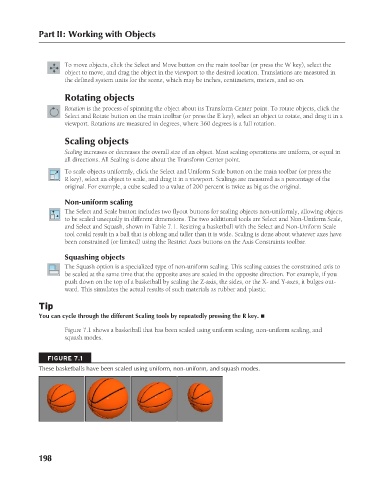Page 246 - Kitab3DsMax
P. 246
Part II: Working with Objects
To move objects, click the Select and Move button on the main toolbar (or press the W key), select the
object to move, and drag the object in the viewport to the desired location. Translations are measured in
the defined system units for the scene, which may be inches, centimeters, meters, and so on.
Rotating objects
Rotation is the process of spinning the object about its Transform Center point. To rotate objects, click the
Select and Rotate button on the main toolbar (or press the E key), select an object to rotate, and drag it in a
viewport. Rotations are measured in degrees, where 360 degrees is a full rotation.
Scaling objects
Scaling increases or decreases the overall size of an object. Most scaling operations are uniform, or equal in
all directions. All Scaling is done about the Transform Center point.
To scale objects uniformly, click the Select and Uniform Scale button on the main toolbar (or press the
R key), select an object to scale, and drag it in a viewport. Scalings are measured as a percentage of the
original. For example, a cube scaled to a value of 200 percent is twice as big as the original.
Non-uniform scaling
The Select and Scale button includes two flyout buttons for scaling objects non-uniformly, allowing objects
to be scaled unequally in different dimensions. The two additional tools are Select and Non-Uniform Scale,
and Select and Squash, shown in Table 7.1. Resizing a basketball with the Select and Non-Uniform Scale
tool could result in a ball that is oblong and taller than it is wide. Scaling is done about whatever axes have
been constrained (or limited) using the Restrict Axes buttons on the Axis Constraints toolbar.
Squashing objects
The Squash option is a specialized type of non-uniform scaling. This scaling causes the constrained axis to
be scaled at the same time that the opposite axes are scaled in the opposite direction. For example, if you
push down on the top of a basketball by scaling the Z-axis, the sides, or the X- and Y-axes, it bulges out-
ward. This simulates the actual results of such materials as rubber and plastic.
Tip
You can cycle through the different Scaling tools by repeatedly pressing the R key. n
Figure 7.1 shows a basketball that has been scaled using uniform scaling, non-uniform scaling, and
squash modes.
FIGURE 7.1
These basketballs have been scaled using uniform, non-uniform, and squash modes.
198
6/30/10 4:15 PM
13_617779-ch07.indd 198
13_617779-ch07.indd 198 6/30/10 4:15 PM

